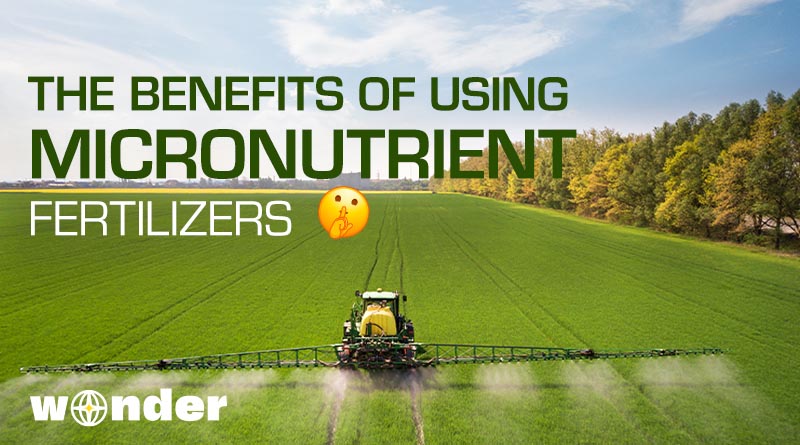The Benefits of Using Microfertilizer
Guest Author: Igor Kovalskiy, Wonder LLC – Ukrainian Manufacturer Of Foliar Fertilizers And Adjuvants, info@wonder-corporation.com
28 March 2024, New Delhi: Regardless of the location or the type of crops the farmers grow, they share a common dream: an abundant harvest. Microfertilizers are the best tools for modern farmers, designed to increase crop yields and improve their quality.
The effectiveness of the absorption of essential micronutrients is directly dependent on their presence in the plant. They are necessary for plants in small quantities. The content of micronutrients is in thousands and ten-thousandths of per cent of the plant mass, but each of them performs certain functions in metabolism and nutrition and cannot be replaced by another element.
How Microfertilizers Affect Crop Nutrition Processes?
The use of micronutrient fertilizers has a positive effect on the main plant nutrition processes, and increases the percentage of assimilation of macronutrient and the resistance of plants to adverse environmental conditions. The main macronutrients are boron, manganese, molybdenum, copper, zinc and iron.
Throughout the entire growth and development period, a plant`s organism needs a complex of micronutrients. In terms of dry matter, its content is not more than one-thousandth of a part of a plant, but they are very useful and play an important role in increasing the activity of enzymes that catalyze biological and chemical processes.
According to global analytical publications, the microfertilizer market in India is valued at USD 701.33 million in 2024 and is expected to reach USD 971.78 million by 2028, at a CAGR of 8.5% during the forecast period (2024-2028).
In addition, with the help of micronutrients, complex compounds are formed from nucleic acids, which affect the properties of cells, root development, the formation of reproductive organs, etc. They are involved in such processes as respiration, photosynthesis (carbohydrate, fat and protein metabolism), enzymes and acids formation, the process of nitrogen fixation, the conversion of phosphorus compounds, and the development of rhizobia.
Fertilizers Based on Microelements, Which Are Popular Nowadays
Today, many farms often use salts of mineral compounds, or their soluble mixture in a tank, or as a single-component micronutrient, due to their low cost and availability. These are mainly copper sulfate, manganese, zinc, cobalt, ammonium molybdate, crystallized iodine solution, ammonium-sodium vanadate, borax, or boric acid. The advantage of sulfates is that they also supply sulfur and sulfate ions to the plant, which are quickly absorbed by plants. However, when used in the fields, the mineral salt of micronutrients is inferior in efficiency to micronutrients of chelated compounds. This is because the doses of chelates are ten times smaller than those of mineral salts, although they provide the same yield increase.
In recent years, the most popular fertiliser has been considered to be a fertiliser based on micronutrients and synthetically derived organic acids. The use of micronutrients is primarily a more efficient, convenient, and cost-effective way to provide plants with the necessary micronutrients, which have a positive effect on strengthening immunity and accelerating growth processes. The benefits of micronutrients have already been recognized by millions of farmers.
Chelated micronutrient fertilisers are made with organic acids that are chemically identical to the natural components of living cells. They also participate in metabolic processes that occur in plants, especially in the Calvin and Krebs cycles.
How does this process work?
When plants encounter chelated micronutrients, they take them as a natural source of not only the necessary biological micronutrients but also as a source of beneficial energy. Synthetic chelates, on the other hand, are virtually unknown in the environment. As a result, plants expend a lot of energy to process or remove foreign synthetic ligands in their bodies during assimilation. Their task is only to serve as a transport for biological micronutrients in the plant. When chelated compounds are used, the plant “takes” only the nutrient it needs, and the chelator (in this case, excess ballast) enters the soil.
Here at Wonder, we use glycine amino acids to produce liquid micronutrient fertilisers. Glycine plays a major role in cell protection from the effects of dehydration (or excess of salt). This amino acid is also used for the complex micronutrients in fertilisers. Because the glycine molecule is much smaller than the molecule of chelating agents that are commonly used (e.g. EDTA, EDDHA), fertilisers that contain it have a higher concentration of micronutrients.
Quite often, agronomists overlook such a key aspect as the quality of working solutions. It is a common practice when products of well-known brands either do not work as claimed by the manufacturer, or to achieve the desired effect, it is necessary to significantly increase the application rate, and therefore pay additional costs. The reason for this may be the excessive hardness of the water used to prepare working solutions, inappropriate pH of the water for mixing, insufficient mixing of the product in the tank, and certain shortcomings in the technology, such as windblown and runoff of the solution from the leaf surface of plants.
That is why the use of spreaders, wetting agents, and stickers must be an essential element of a quality process of plant protection and fertilisation. The combination of these products allows you to keep the working solution on the leaf surface and prolong its action by absorbing atmospheric moisture and, accordingly, assimilation by plants.
At the same time, it is important to ensure the normal acidity of the water for solutions. When using water with a pH of 7 and above, the effectiveness of many products decreases by 30-50% within a few hours.
It is important to take into account weather and climatic conditions, phases of growth and development of the plant, and the needs of each crop for individual elements.
Thus, investing in microfertilizers is a crucial element in agriculture and horticulture, helping to optimize plant growth and development. The production of microfertilizers is a highly promising field today. This is because their application not only improves seed quality but is also cost-effective, which is of great importance to farmers worldwide.
(For Latest Agriculture News & Updates, follow Krishak Jagat on Google News)















